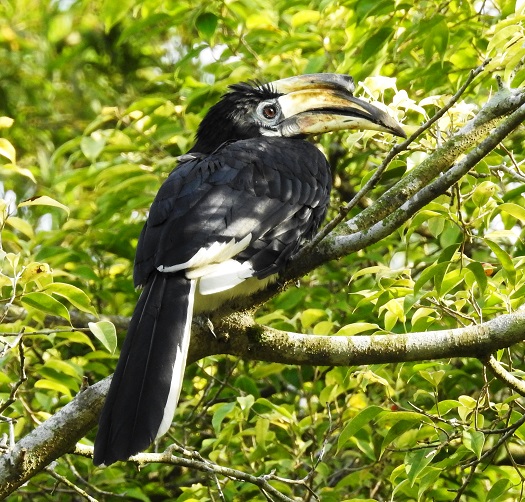By Gloria Seow, Vice Chairperson Education Committee
Photos by Gloria Seow & Lena Chow
The Moulmein-Goldhill Community Garden brims with the earth’s goodness.
Despite
the looming school exams, a group of children and their parents turned up to
admire the lush and beautiful Moulmein-Goldhill Community Garden on 29
September 2018. Led by Auntie Angel Ang who lives a literal stone’s throw away,
we were brought on a tour of the substantial plot of community land brimming
with the earth’s goodness.
Under
the loving care of 30 odd volunteer gardeners, this award-winning garden was
heaving with fruit trees such as Papaya, Banana, Breadfruit, Starfruit and Kedondong.
Auntie Lena Chow then pointed out the strange and barely-visible Starfruit
Plume Moth. There were rows of leafy pesticide-free vegetables growing under
mesh to protect them from insects and the harsh tropical sun. Vegetable
saplings are purchased from local farms and take about a month to mature. Auntie
Angel rattled off the various greens growing such as Cai Xin and Xiao Bai Cai,
which to the untrained eye were difficult to tell apart. One of these
vegetables has a funny Hokkien name ‘Pa Bor Cai’ (translated as Beat Wife
Vegetable). Auntie Angel then told the story of a husband attributing the
reason of a stack of vegetables shrinking substantially when cooked to his wife
having a lover, and consequently beating her up.
Auntie Angel telling us about the many facets of her award-winning community
garden.
We
also found many other edibles growing, from Lime and Lady’s Fingers to pretty Double
Blue Pea flowers. The garden also has decorative ornamental plants, lattice
work and rock garden features. Auntie Angel revealed that to win competitions, she
and her gardeners outdo themselves every year by growing “difficult” plants
such as Dry Padi (rice). The kids were pleased to spot the Four-lined Treefrog
that lives in the pond area.
The tiny Starfruit Plume Moth on the leaf of the
Starfruit.
Auntie
Angel’s husband Uncle Milton Ang then took over to tell us the story behind the
creation of the garden and nearby Malcolm Park (where great birds like the
Crested Serpent Eagle can be found). Malcolm Park and the garden itself were
once forested areas. Malcolm Park is one of the reasons why the Bukit Timah
area no longer experiences major floods. Singapore’s Water Agency PUB built a huge
storm drain through Malcolm Park to link the Bukit Timah canal with the Thomson
canal, so that excess rainfall can be shunted in either direction. The patch
that is now the community garden was cleared to facilitate the removal of a
hornet’s nest in the forest behind. The residents proposed a community garden in
its place.
Our stroll through Malcolm Park produced the charming Oriental Pied Hornbill.
Uncle
Milton also related that during the infamous Mas Selamat escape from the nearby
Whitley Road Detention Centre, the police swarmed the Malcolm Park and Goldhill
neighbourhoods in door-to-door searches. We then strolled through Malcolm Park itself
for a spot of birdwatching. The place is a known stake-out for long-lens photographers
to shoot the resident Crested Serpent Eagle. Although we did not see the eagle,
we were rewarded almost immediately with a pair of Oriental Pied Hornbills that
flew in and landed at close range. We scoped the Asian Glossy Starling and
Pink-necked Green Pigeon, and encountered many other birds including flocks of
Red-breasted Parakeets and the Black-naped Oriole. The globally-threatened
Straw-headed Bulbul serenaded us with its distinctive call. We even had fun
harvesting fragrant Pandan leaves with pen knives. Auntie Lena Chow identified
a couple of dragonflies that hung out at the stream.
We ended with a delectable community feast prepared by Uncle Milton and Auntie
Angel.
Back
at the community garden, we trooped into the airy shelter where Uncle Milton
and Auntie Angel had graciously prepared for us a feast of Putu Mayam (an
Indian snack) and two kinds of Goreng Pisang (deep-fried banana) which we washed
down with refreshing Lemon Grass drink. We thank them for being the perfect
hosts.



















